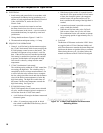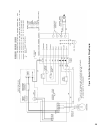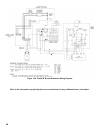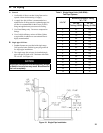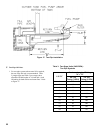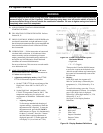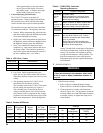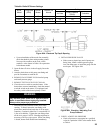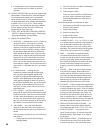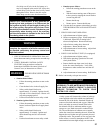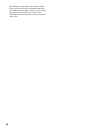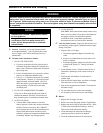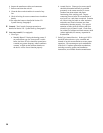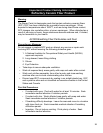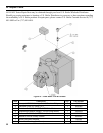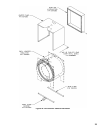26
b. For adjustment, locate oil pressure adjusting
screw and turn screw to obtain oil pressure
specied.
10. ADJUST AIR SETTING on burner for alight orange
colored ame. Flame should be solid and compact.
Use smoke tester and adjust air for a minimum
smoke (not to exceed #1) with a minimum excess
air. Make nal check using suitable instrumentation
to obtain CO2 of 11.5% to 12%. These settings
will assure a safe and efcient operating condition.
If ame appears stringy instead of solid re, try
another nozzle of the same type.
11. TURN "OFF" BURNER BY OPENING SERVICE
SWITCH. Remove pressure gauge. Install gauge
port plug and tighten. Re-start burner.
12. HINTS ON COMBUSTION
a. NOZZLES — Although the nozzle is a relatively
inexpensive device, its function is critical to
the successful operation of the oil burner. The
selection of the nozzle supplied with the LEDV
boiler is the result of extensive testing to obtain
the best ame shape and efcient combustion.
Other brands of the same spray angle and spray
pattern may be used but may not perform at the
expected level of CO
2
and smoke. Nozzles are
delicate and should be protected from dirt and
abuse. Nozzles are mass-produced and can vary
from sample to sample. For all of those reasons a
spare nozzle is a desirable item for a serviceman
to have.
b. FLAME SHAPE — Looking into the
combustion chamber through the ame plug
hole, the ame should appear straight with
no sparklers rolling up toward the top of the
chamber. If the ame drags to the right or left,
sends sparklers upward or makes wet spots on
the rear door insulation piece, the nozzle should
be replaced. If the condition persists look for
fuel leaks, air leaks, water or dirt in the fuel as
described below.
c. FUEL LEAKS — Any fuel leak between the
pump and the nozzle will be detrimental to good
combustion results. Look for wet surfaces in the
air tube, under the transformer, and around the
air inlet. Any such leaks should be repaired as
they may cause erratic burning of the fuel and in
the extreme case may become a re hazard.
d. AIR LEAKS — Any such leaks should be
repaired, as they may cause erratic burning of
the fuel and in extreme cases may become a re
hazard.
There are many possible causes of air leaks in oil
lines such as:
i. Fitting leaks due to mis-ared tubing or
damaged tting.
ii. Fuel line leak due to crushed or bent tubing.
iii. Filter connection leaks.
iv. Tank connection leaks.
There are various test kits available to trace
air leaks, such as electronic sight glasses.
Follow the manufacturers' instructions to
nd air leaks.
The following actions can eliminate air leaks:
i. Bleed pump as detailed in System Start-Up
Section of this manual.
ii. Replace are ttings.
iii. Replace oil supply line.
iv. Repair oil lter leaks.
v. Replace or repair tank ttings.
e. GASKET LEAKS — If 11.5 to 12.5% CO
2
with
a #1 smoke cannot be obtained in the breeching,
look for air leaks around the ue collar. Such
air leaks will cause a lower CO
2
reading in the
breeching. The smaller the ring rate the greater
effect an air leak can have on CO
2
readings.
f. DIRT — A fuel lter is a good investment.
Accidental accumulation of dirt in the fuel
system can clog the nozzle or nozzle strainer and
produce a poor spray pattern from the nozzle.
The smaller the ring rate, the smaller the slots
become in the nozzle and the more prone to
plugging it becomes with the same amount of
dirt.
g. WATER — Water in the fuel in large amounts
will stall the fuel pump. Water in the fuel in
smaller amounts will cause excessive wear on
the pump, but more importantly water doesn’t
burn. It chills the ame and causes smoke and
unburned fuel to pass out of the combustion
chamber and clog the ueways of the boiler.
h. COLD OIL — If the oil temperature approaching
the fuel pump is 40°F or lower poor combustion
or delayed ignition may result. Cold oil is harder
to atomize at the nozzle. Thus, the spray droplets
get larger and the ame shape gets longer. An
outside fuel tank that is above grade or has fuel
lines in a shallow bury is a good candidate for
cold oil. The best solution is to bury the tank and
lines deep enough to keep the oil above 40°F.
i. HIGH ALTITUDE INSTALLATIONS — Air
settings must be increased at higher altitudes.
Use instruments and set for 11.5 to 12.5% CO
2
.
j. START-UP NOISE — Late ignition is the
cause of start-up noises. If it occurs recheck for
electrode settings, ame shape, air or water in
the fuel lines.
k. SHUT DOWN NOISE — If the ame runs out
of air before it runs out of fuel, an after burn
with noise may occur. That may be the result



